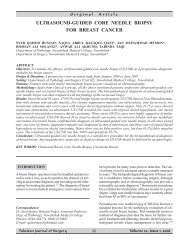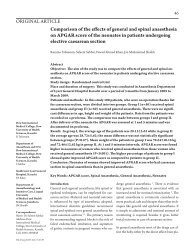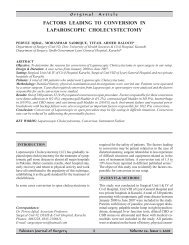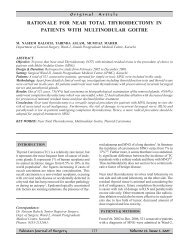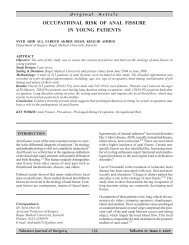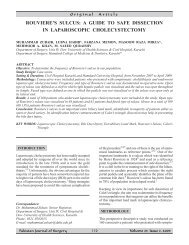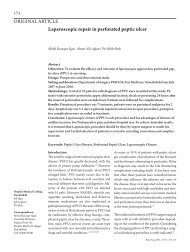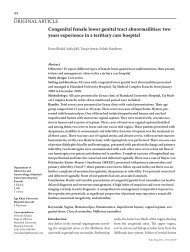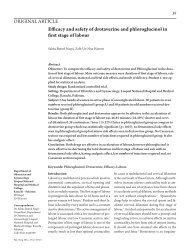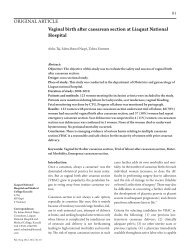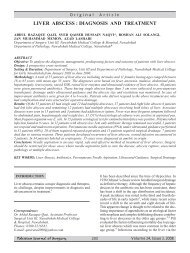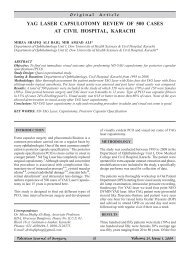different modalities for the treatment of liver abscess - Pakistan ...
different modalities for the treatment of liver abscess - Pakistan ...
different modalities for the treatment of liver abscess - Pakistan ...
Create successful ePaper yourself
Turn your PDF publications into a flip-book with our unique Google optimized e-Paper software.
Original<br />
Article<br />
DIFFERENT MODALITIES FOR THE TREATMENT<br />
OF LIVER ABSCESS<br />
M. NAJMUDDIN SHABBIR, MISBAH NIZAMI, ZAHID ALI MEMON, RIAZUDDIN KHANZADA<br />
Department <strong>of</strong> General Surgery, Liaquat College <strong>of</strong> Medicine and Dentistry, Karachi<br />
ABSTRACT<br />
Objective: To evaluate <strong>the</strong> <strong>treatment</strong> <strong>of</strong> <strong>liver</strong> <strong>abscess</strong>.<br />
Study Design: Quasi experimental.<br />
Setting & Duration: Liaquat National Hospital, Liaquat College <strong>of</strong> Medicine and Dentistry, Darul Sehat Hospital,<br />
SESSI Landhi Hospital, Karachi from January 2007 to June 2007.<br />
Methodology: All patients with <strong>liver</strong> <strong>abscess</strong> were included in this study and were exposed to four <strong>different</strong> <strong>treatment</strong><br />
<strong>modalities</strong>. The patients were first treated with combination <strong>of</strong> medicine (option a). If <strong>the</strong>y failed to respond to this<br />
<strong>treatment</strong> <strong>the</strong>n <strong>the</strong>y were subjected to ultrasound guided aspiration (option b). If option b failed <strong>the</strong>y were exposed<br />
to pig tail ca<strong>the</strong>ter placement (option c). Final option was surgical drainage (option d).<br />
Result: Out <strong>of</strong> 51 patients, 20(39.2%) patients responded to drug <strong>the</strong>rapy alone. Twenty two patients required<br />
ultrasound guided aspiration and 9 patients required Pig tail Ca<strong>the</strong>ter placement and 6 patients required open<br />
surgical drainage. A combination <strong>of</strong> drug <strong>the</strong>rapy and ultrasound guided needle aspiration was effective <strong>for</strong> majority<br />
<strong>of</strong> 83% patients.<br />
Conclusion: Majority <strong>of</strong> patients with unruptured <strong>liver</strong> <strong>abscess</strong> can be managed without conventional surgery.<br />
KEY WORDS: Liver Abscess, Pig Tail Ca<strong>the</strong>ter, Needle Aspiration, Medical Treatment, Open Surgical Drainage<br />
INTRODUCTION<br />
Amoebic <strong>liver</strong> <strong>abscess</strong> affects 10% <strong>of</strong> <strong>the</strong> world’s population<br />
and is <strong>the</strong> most common <strong>for</strong>m <strong>of</strong> <strong>liver</strong> <strong>abscess</strong>.<br />
It has a approximate 18% morbidity. 1 It has higher<br />
incidence in <strong>the</strong> under developed countries because <strong>of</strong><br />
lower standard <strong>of</strong> sanitation. Liver <strong>abscess</strong> results in<br />
many deaths annually world wide, and affects nearly<br />
70 to 100 million individuals annually. The right lobe<br />
<strong>of</strong> <strong>the</strong> <strong>liver</strong> is more involved than <strong>the</strong> left 2 , and, <strong>the</strong><br />
male sex is predominantly involved.<br />
In a past study published in <strong>the</strong> World Journal <strong>of</strong> Surgery 3<br />
it was seen that <strong>the</strong> best <strong>for</strong>m <strong>of</strong> <strong>treatment</strong> is conservative.<br />
Correspondence:<br />
Pr<strong>of</strong>. M. Najmuddin Shabbir<br />
Head Department <strong>of</strong> General Surgery,<br />
Liaquat College <strong>of</strong> Medicine & Dentistry, Karachi.<br />
Phones: 0300-8229833.<br />
E-mail: drnajamshabbir461@hotmail.com<br />
The management was ei<strong>the</strong>r medical or surgical. Those<br />
<strong>abscess</strong>es less than 5cm were seen to resolve with medical<br />
<strong>treatment</strong> and those with a size <strong>of</strong> 5 to 10cm would<br />
subside with subsequent aspiration.<br />
METHODOLOGY<br />
Prospective study is carried out in 51 patients with <strong>liver</strong><br />
<strong>abscess</strong> over a period <strong>of</strong> 6 month at Liaquat National<br />
Hospital (LNH), Liaquat College <strong>of</strong> Medical and Dentistry<br />
(LCMD) and Sindh Employees Social Security<br />
Institution Hospital Landhi (SESSI). After classifying<br />
<strong>the</strong> lesion according to <strong>the</strong> size on ultrasound <strong>the</strong> patients<br />
were subjected to general and abdominal examination.<br />
Necessary baseline investigations were done. Selected<br />
patients underwent additional investigation like Contrast<br />
Gastointestinal studies, CT Scan, according to <strong>the</strong><br />
symptology.<br />
Inclusion Criteria:<br />
1. All patients above 12 years were included in this<br />
study.<br />
2. Only new cases were included in this study.<br />
3. Amoebic and Pyogenic <strong>abscess</strong>es diagnosed on <strong>the</strong><br />
22<br />
Volume 25, Issue 1, 2009
Different <strong>modalities</strong> <strong>for</strong> <strong>the</strong> treament <strong>of</strong> <strong>liver</strong> <strong>abscess</strong><br />
M. N. Shabbir, M. Nizam<br />
basis <strong>of</strong> investigations were included.<br />
DISCUSSION<br />
Exclusion Criteria:<br />
1. Pregnant patients.<br />
2. H.I.V diagnosed positive patients or immunocompromised<br />
patients.<br />
RESULTS<br />
During 6 months period between January 2007 to June<br />
2007. Fifty one patients with <strong>the</strong> diagnosis <strong>of</strong> <strong>liver</strong><br />
<strong>abscess</strong> fulfilled <strong>the</strong> criteria and were included in <strong>the</strong><br />
prospective study. The age range was between 15 to75<br />
years with <strong>the</strong> mean age <strong>of</strong> 40 years. 39(76.5%) <strong>of</strong> our<br />
patients were male while 12(23.5%) were females with<br />
a male to female ratio <strong>of</strong> 3.1:2. Jaundice was present in<br />
29 patients while 21 patients were not jaundiced at <strong>the</strong><br />
time <strong>of</strong> presentation (Table I). Total White Cell Count<br />
ranged from 17000 to 37300 per cubic millilitre. Erythrocyte<br />
Sedimentation Rate in 1st hour ranged between 1<br />
to 178.<br />
Sign<br />
Jaundice +ve<br />
Jaundice -ve<br />
Total<br />
No. <strong>of</strong> patients<br />
29<br />
22<br />
51<br />
Table I. Frequency <strong>of</strong> jaundice<br />
%<br />
56.9<br />
43.1<br />
100<br />
Liver Function Test <strong>of</strong> 51 patients revealed Total Billirubin<br />
<strong>of</strong> 0.24 to13.5 mg/dl. SGPT ranged from 18 to<br />
283 mg/dl. Alkaline phosphatase ranged from 67-874<br />
mg/dl.<br />
X-ray chest P.A view showed 6 patients (11.8%) had<br />
elevated Rt. Hemidiaphragm and Rt. sided pleural effusion<br />
was seen in 9. Forty three (83.3%) patients presented<br />
with Right lobe <strong>abscess</strong>, and Left lobe <strong>abscess</strong> was seen<br />
in 8(15.7%) patients. Abscesses were categorized into<br />
three groups according to size and <strong>treatment</strong> (see Table<br />
II).<br />
Table II. Size <strong>of</strong> <strong>abscess</strong> and <strong>treatment</strong><br />
Various surveys have disclosed that a significant percentage<br />
<strong>of</strong> <strong>the</strong> world’s population harbors <strong>the</strong> parasite (E.<br />
Histolytica). 4 The incidence <strong>of</strong> hepatic <strong>abscess</strong> continues<br />
to be high in patients with intestinal amebiasis varying<br />
from 2.5 to 2.8% with an average incidence <strong>of</strong> 13.2%. 8<br />
Amebic <strong>liver</strong> <strong>abscess</strong> is encountered predominantlyin<br />
<strong>the</strong> third, fourth and fifth decades 2 , The male to female<br />
was 3.1:1. In this series presented with pain in <strong>the</strong> right<br />
hypochrondrium, malaise, fever and rigors. 5 The total<br />
leucocyte count ranged from 1.70x10/liter to 37.3x10/<br />
liter. 6 As <strong>for</strong> <strong>the</strong> ESR it ranged from 1 to 178. Tests<br />
included total bilirubin, SGPT and Alkaline phosphatase.<br />
Total bilirubin ranged from 24 to 13.5 mg/dl. The<br />
alkaline phosphatase ranged from 67 to 874mg/dl. 6<br />
Chest X-ray was done to see <strong>the</strong> presence <strong>of</strong> elevated<br />
right hemidiaphargm and right sided pleural effusion.<br />
Ultrasound followed to determine <strong>the</strong> site, number and<br />
size <strong>of</strong> <strong>the</strong> <strong>abscess</strong> in <strong>the</strong> <strong>liver</strong>. There were six patients<br />
(11.8%) who had elevated right hemidiaphragm. Right<br />
sided pleural effusion was in 9(7.6%) <strong>of</strong> <strong>the</strong> fifty one<br />
patients. The right lobe <strong>of</strong> <strong>the</strong> <strong>liver</strong> was predominantly<br />
involved in 43 out <strong>of</strong> fifty-one patients (83%). Considering<br />
<strong>the</strong> size <strong>of</strong> <strong>the</strong> <strong>abscess</strong>es <strong>of</strong> less than 5cms responded<br />
to drug <strong>the</strong>rapy alone. Those between 5-10cm, 26(86.6%)<br />
responded to ei<strong>the</strong>r drug <strong>the</strong>rapy Table II a combination<br />
<strong>of</strong> needle aspiration and Drug <strong>the</strong>rapy. In <strong>abscess</strong> size<br />
>10 cm 61.5% <strong>of</strong> patients responded to <strong>the</strong> combination<br />
<strong>of</strong> drugs alone with needle aspiration. In 1996 Seeto 7<br />
proved that percutaneous drainage combined with intravenous<br />
antibiotics was <strong>the</strong> most common <strong>the</strong>rapeutic<br />
modality and resulted in cure <strong>of</strong> 76% <strong>of</strong> all patients in<br />
which it was used. As seen by <strong>the</strong> references above and<br />
from <strong>the</strong> result <strong>of</strong> this small series, <strong>the</strong> best from <strong>of</strong><br />
<strong>treatment</strong> <strong>for</strong> most <strong>liver</strong> <strong>abscess</strong>es is drug <strong>the</strong>rapy and<br />
needle aspiration followed by surgical intervention<br />
depending on <strong>the</strong> response <strong>of</strong> <strong>the</strong> patients who have<br />
signs <strong>of</strong> peritonitis or large left lobe <strong>abscess</strong>es which<br />
are vulnerable to response.<br />
Liver <strong>abscess</strong> represent significant morbidity <strong>for</strong> <strong>the</strong><br />
patients, who may present without classical triad <strong>of</strong><br />
Treatment<br />
0 - 5 cms<br />
5 - 10 cms<br />
> 10 cms<br />
Total<br />
Medical<br />
8<br />
10<br />
3<br />
21<br />
Aspiration<br />
-<br />
16<br />
5<br />
21<br />
Pigtail Ca<strong>the</strong>ter<br />
-<br />
2<br />
1<br />
3<br />
Surgery<br />
-<br />
2<br />
4<br />
6<br />
Total<br />
8<br />
30<br />
13<br />
15<br />
23<br />
Volume 25, Issue 1, 2009
Different <strong>modalities</strong> <strong>for</strong> <strong>the</strong> treament <strong>of</strong> <strong>liver</strong> <strong>abscess</strong><br />
M. N. Shabbir, M. Niza<br />
right upper quadrant pain, fever and hepatomegaly.<br />
Differentiation between bacterial and amoebic etiology<br />
is important 9 , but can be difficult due to similarities. 8<br />
Ultrasound examination by an experienced radiologist<br />
appears to be <strong>the</strong> single most important tool <strong>for</strong> diagnosis<br />
as well as <strong>treatment</strong>. Combination drug <strong>the</strong>rapy is <strong>the</strong><br />
mainstay <strong>of</strong> <strong>treatment</strong> <strong>for</strong> all types<strong>of</strong> <strong>liver</strong> <strong>abscess</strong>es. 2<br />
Patients <strong>of</strong> <strong>liver</strong> <strong>abscess</strong> with size < 10cm should be<br />
managed with needle aspiration and drug <strong>the</strong>rapy. Abscess<br />
size <strong>of</strong> >10cm and left lobe location requires careful<br />
in-hospital follow-up to evaluate <strong>for</strong> impending rupture<br />
and signs <strong>of</strong> peritonitis.<br />
CONCLUSION<br />
Majority <strong>of</strong> patients with unruptured <strong>liver</strong> <strong>abscess</strong> can<br />
be managed without conventional surgery.<br />
REFERENCES<br />
1. Li E, Stanley S L, Protozoa: Amoebiasis. In gastroenterology<br />
Clinic <strong>of</strong> North America 1996; 25(3):<br />
471-492.<br />
2. Sharma M P, Ahuja V. Amoebic Liver Abscess.<br />
Journ Ind Acad <strong>of</strong> Clin Med 2003; 4(2): 107-11.<br />
3. Akgun Y, Tacyildiz I H, Celik Y. Amoebic <strong>liver</strong><br />
<strong>abscess</strong> changing trends over 20 years, World Journ<br />
<strong>of</strong> Surgery 1999; 23(1): 102-106.<br />
4. Memon G A, Memon A Q, Solangi R A. An experience<br />
with Amoebic Liver Abscess at PMCH<br />
Nawabshah Medical College. Med Channel 1999;<br />
5(2): 12-14.<br />
5. Wynants H, Van Den Ende J, Randria J, Van Gompel<br />
A, Van Den Enden, Brand C. Colebunders R Ann<br />
Soc Belg Med Trop 1995; 75(4): 297-303.<br />
6. Chou F F, Sheen Chen S M, Chen Mc. Single and<br />
multiple pyogenic <strong>liver</strong> <strong>abscess</strong>es: clinical course<br />
etiology, and result <strong>of</strong> <strong>treatment</strong>. World Journ Surg<br />
1997; 21(4): 384-8.<br />
7. Seeto R K, Rockey D C. Pyogenic Liver <strong>abscess</strong>.<br />
Changes in etiology, management and outcome.<br />
Medicine Baltimore 1996; 75(2): 99-113.<br />
8. Barakate M S, Stephen M S, Waugh R C. Pyogenic<br />
<strong>liver</strong> <strong>abscess</strong>: a review <strong>of</strong> 10 years’ experience in<br />
management. Aust N Z J Surg 1999; 69(3): 205-9.<br />
9. Kurland J E, Brann O S. Pyogenic and amoebic<br />
<strong>liver</strong> <strong>abscess</strong>es, Current gastroenterology Reports,<br />
2004; 6(4): 273-9.<br />
24<br />
Volume 25, Issue 1, 2009



